AMD Kaveri Review: A8-7600 and A10-7850K Tested
by Ian Cutress & Rahul Garg on January 14, 2014 8:00 AM ESTCPU Performance
I often make a big song and dance about real world benchmarks being the main focus of a reviewer. Synthetics often stress parts of the CPU and distort advantages that a CPU might have and thus not affect you or me in the same manner when using the machine normally. For 2014 I have updated my usual benchmarking set, to include more video encoding and an image converter that takes 2D images and performs algorithms to convert the data into a 3D model. Some 2013 benchmarks are still here, showing what can be done, and to bring parity to previous CPU reviews, some synthetics are also included.
Agisoft Photoscan v1.0 - link
Our new main benchmark to AnandTech is provided by Agisoft. Their Photoscan software creates 3D models from 2D images, a process which is very computationally expensive. The algorithm is split into four distinct phases, and different phases of the model reconstruction require either fast memory, fast IPC, more cores, or even OpenCL compute devices to hand. Agisoft supplied us with a special version of the software to script the process, where we take 50 images of a stately home and convert it into a medium quality model. This benchmark typically takes around 15-20 minutes on a high end PC on the CPU alone, with GPUs reducing the time.
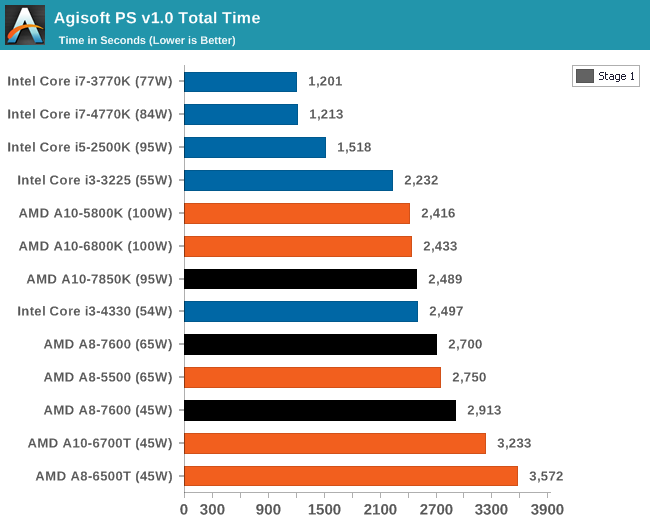
AMD suffers in overall time due to the lack of full-blooded cores and the reliance on single threaded performance in certain parts of the algorithm.
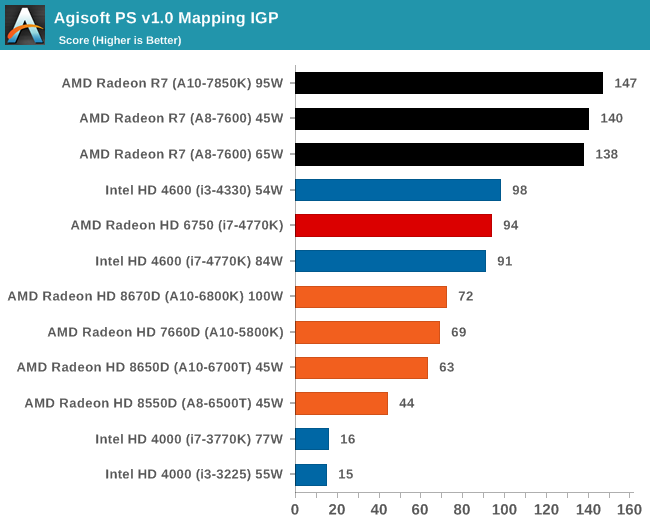
The second stage of the benchmark can be accelerated by the IGP of an APU, and as a result we can see the power of the high end APUs for this work can outshine any CPU we tested today. This is really the promise of HSA, it's just going to take a while to get there for most apps.
3D Particle Movement - link
3DPM is a self-penned benchmark, taking basic 3D movement algorithms used in Brownian Motion simulations and testing them for speed. High floating point performance, MHz and IPC wins in the single thread version, whereas the multithread version has to handle the threads and loves more cores.
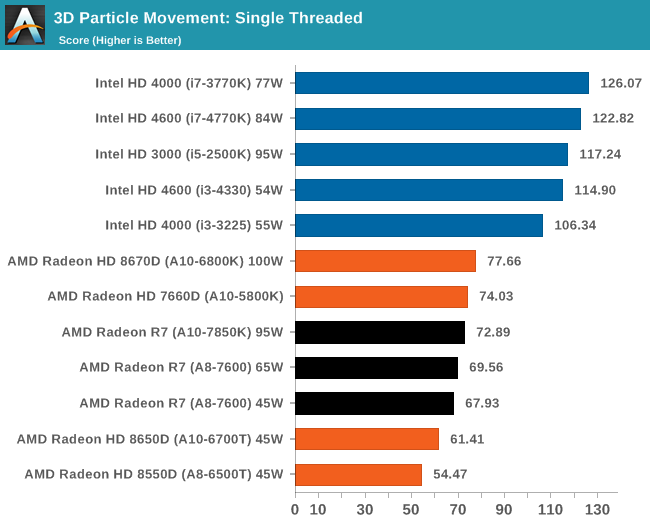
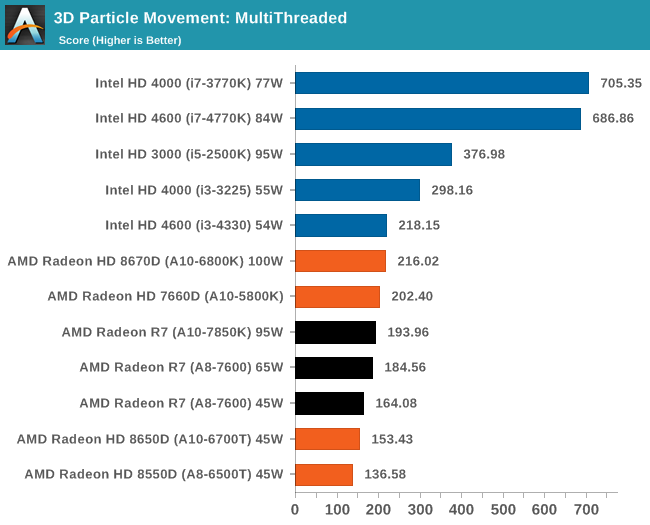
AMD is still suffering a lack of FP performance in our 3DPM benchmark.
WinRAR 5.01 - link
Our WinRAR test from 2013 is updated to the latest version of WinRAR at the start of 2014. We compress a set of 2867 files across 320 folders totaling 1.52 GB in size – 95% of these files are small typical website files, and the rest (90% of the size) are small 30 second 720p videos.
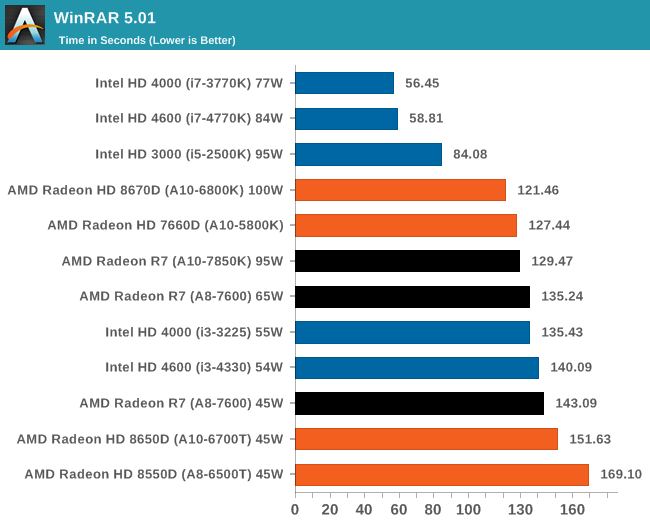
WinRAR loves IPC from the high end Intel chips, but even against the older i5-2500K there is still a deficit. The 45W Kaveri APU however is within fighting distance of its main rival.
FastStone Image Viewer 4.9 - link
Similarly to WinRAR, the FastStone test us updated for 2014 to the latest version. FastStone is the program I use to perform quick or bulk actions on images, such as resizing, adjusting for color and cropping. In our test we take a series of 170 images in various sizes and formats and convert them all into 640x480 .gif files, maintaining the aspect ratio. FastStone does not use multithreading for this test, and thus single threaded performance is often the winner.
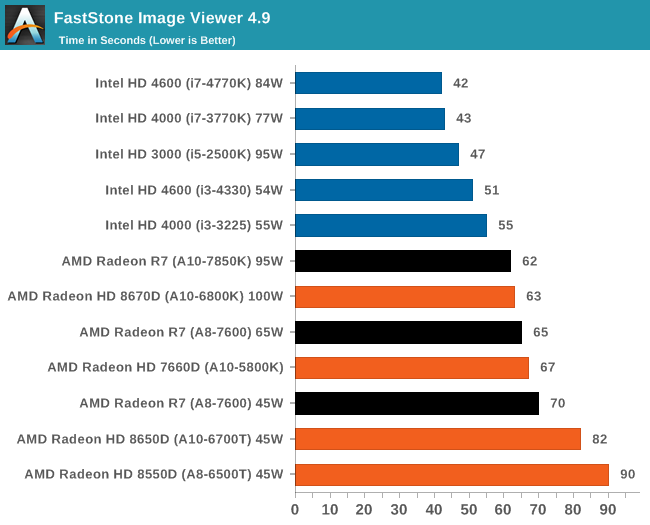
FastStone wants single threaded performance, so Intel wins here again.










380 Comments
View All Comments
dbcoopernz - Tuesday, January 14, 2014 - link
I'd like an APU with enough GPU power to run all the high quality options in MadVR. Would make a very nice HTPC chip.thomascheng - Tuesday, January 14, 2014 - link
I think Mantle can make that happen, but will see how much support they get.MrSpadge - Tuesday, January 14, 2014 - link
Mantle has nothing to do with GP-GPU, that's not using DirectX anyway.JDG1980 - Tuesday, January 14, 2014 - link
My discrete 7750 couldn't handle Jinc scaling in MadVR (at least not without dropping frames on some 1080i test clips), so this is going to be another generation or two in the future.The PS4 APU could probably do it, if that was available in a generic PC form factor.
MrSpadge - Tuesday, January 14, 2014 - link
Add to that DDR4 and/or 4 memory channels, or at least a large on-package buffer like Crystal Well.yankeeDDL - Wednesday, January 15, 2014 - link
But the whole point of HSA is to get the GPU to do CPU work that it could do better (like FP).So you wouldn't need more CPU cores at all.
Look at it this way: AMD's CPU is less efficient than Intel's, while the GPU is more efficient.
Having a CPU-imbalanced APU, would put it in a tough(er) spot to compete against Intel. A GPU imbalanced, as Kaveri is, would improve the lead than it already has on the GPU side.
Now imagine that HSA kicks in, and the GPU lead translates directly in CPU lead ...
mikato - Wednesday, January 15, 2014 - link
This is true. I hope we see more articles as adoption of HSA starts to take hold.It is too bad they are far behind in CPU power, but AMD has the right strategy. Either way, some things are better done on the GPU. AMD just has more benefit than Intel to get things moving that way sooner with their GPU advantage and CPU disadvantage. Intel will have no choice but to follow that lead.
nissangtr786 - Tuesday, January 14, 2014 - link
http://www.extremetech.com/computing/174632-amd-ka...hsa does well on amd main thing they marketed in libreoffice.
Ryan Smith - Tuesday, January 14, 2014 - link
I'm normally not one to speak about other articles, but those are all OpenCL benchmarks. The OpenCL HSA driver won't be released for another quarter. And the HSA SDK is similarly far off.http://www.anandtech.com/show/7677/amd-kaveri-revi...
krumme - Tuesday, January 14, 2014 - link
What a bencmark of a review. I learned a lot. Great. Thanx.